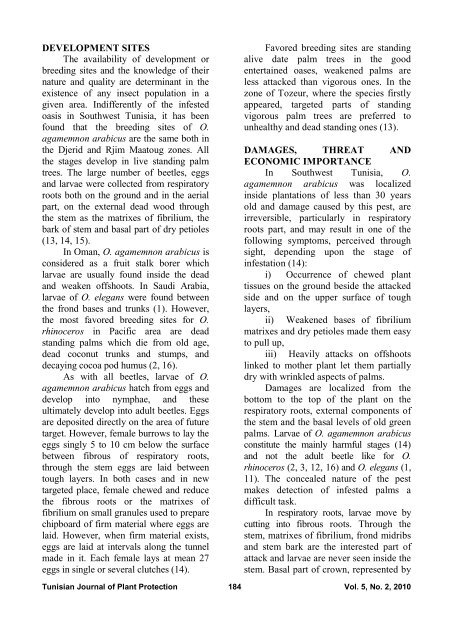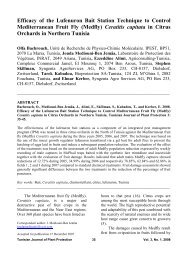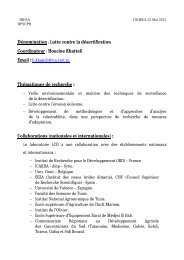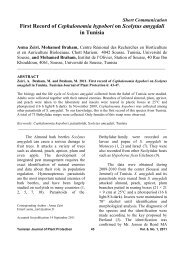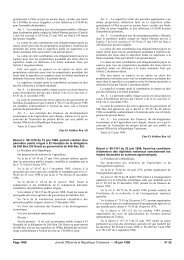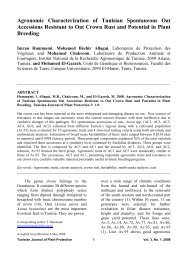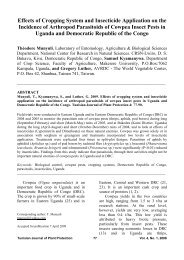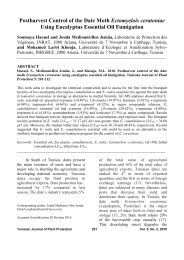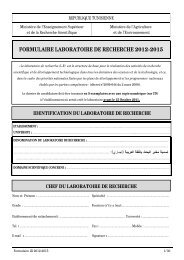The Rhinoceros Beetle Oryctes agamemnon arabicus in ... - Iresa
The Rhinoceros Beetle Oryctes agamemnon arabicus in ... - Iresa
The Rhinoceros Beetle Oryctes agamemnon arabicus in ... - Iresa
Create successful ePaper yourself
Turn your PDF publications into a flip-book with our unique Google optimized e-Paper software.
DEVELOPMENT SITES<strong>The</strong> availability of development orbreed<strong>in</strong>g sites and the knowledge of theirnature and quality are determ<strong>in</strong>ant <strong>in</strong> theexistence of any <strong>in</strong>sect population <strong>in</strong> agiven area. Indifferently of the <strong>in</strong>festedoasis <strong>in</strong> Southwest Tunisia, it has beenfound that the breed<strong>in</strong>g sites of O.<strong>agamemnon</strong> <strong>arabicus</strong> are the same both <strong>in</strong>the Djerid and Rjim Maatoug zones. Allthe stages develop <strong>in</strong> live stand<strong>in</strong>g palmtrees. <strong>The</strong> large number of beetles, eggsand larvae were collected from respiratoryroots both on the ground and <strong>in</strong> the aerialpart, on the external dead wood throughthe stem as the matrixes of fibrilium, thebark of stem and basal part of dry petioles(13, 14, 15).In Oman, O. <strong>agamemnon</strong> <strong>arabicus</strong> isconsidered as a fruit stalk borer whichlarvae are usually found <strong>in</strong>side the deadand weaken offshoots. In Saudi Arabia,larvae of O. elegans were found betweenthe frond bases and trunks (1). However,the most favored breed<strong>in</strong>g sites for O.rh<strong>in</strong>oceros <strong>in</strong> Pacific area are deadstand<strong>in</strong>g palms which die from old age,dead coconut trunks and stumps, anddecay<strong>in</strong>g cocoa pod humus (2, 16).As with all beetles, larvae of O.<strong>agamemnon</strong> <strong>arabicus</strong> hatch from eggs anddevelop <strong>in</strong>to nymphae, and theseultimately develop <strong>in</strong>to adult beetles. Eggsare deposited directly on the area of futuretarget. However, female burrows to lay theeggs s<strong>in</strong>gly 5 to 10 cm below the surfacebetween fibrous of respiratory roots,through the stem eggs are laid betweentough layers. In both cases and <strong>in</strong> newtargeted place, female chewed and reducethe fibrous roots or the matrixes offibrilium on small granules used to preparechipboard of firm material where eggs arelaid. However, when firm material exists,eggs are laid at <strong>in</strong>tervals along the tunnelmade <strong>in</strong> it. Each female lays at mean 27eggs <strong>in</strong> s<strong>in</strong>gle or several clutches (14).Favored breed<strong>in</strong>g sites are stand<strong>in</strong>galive date palm trees <strong>in</strong> the goodenterta<strong>in</strong>ed oases, weakened palms areless attacked than vigorous ones. In thezone of Tozeur, where the species firstlyappeared, targeted parts of stand<strong>in</strong>gvigorous palm trees are preferred tounhealthy and dead stand<strong>in</strong>g ones (13).DAMAGES, THREAT ANDECONOMIC IMPORTANCEIn Southwest Tunisia, O.<strong>agamemnon</strong> <strong>arabicus</strong> was localized<strong>in</strong>side plantations of less than 30 yearsold and damage caused by this pest, areirreversible, particularly <strong>in</strong> respiratoryroots part, and may result <strong>in</strong> one of thefollow<strong>in</strong>g symptoms, perceived throughsight, depend<strong>in</strong>g upon the stage of<strong>in</strong>festation (14):i) Occurrence of chewed planttissues on the ground beside the attackedside and on the upper surface of toughlayers,ii) Weakened bases of fibriliummatrixes and dry petioles made them easyto pull up,iii) Heavily attacks on offshootsl<strong>in</strong>ked to mother plant let them partiallydry with wr<strong>in</strong>kled aspects of palms.Damages are localized from thebottom to the top of the plant on therespiratory roots, external components ofthe stem and the basal levels of old greenpalms. Larvae of O. <strong>agamemnon</strong> <strong>arabicus</strong>constitute the ma<strong>in</strong>ly harmful stages (14)and not the adult beetle like for O.rh<strong>in</strong>oceros (2, 3, 12, 16) and O. elegans (1,11). <strong>The</strong> concealed nature of the pestmakes detection of <strong>in</strong>fested palms adifficult task.In respiratory roots, larvae move bycutt<strong>in</strong>g <strong>in</strong>to fibrous roots. Through thestem, matrixes of fibrilium, frond midribsand stem bark are the <strong>in</strong>terested part ofattack and larvae are never seen <strong>in</strong>side thestem. Basal part of crown, represented byTunisian Journal of Plant Protection 184 Vol. 5, No. 2, 2010


